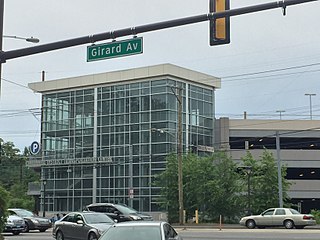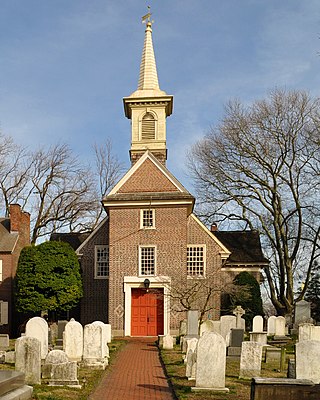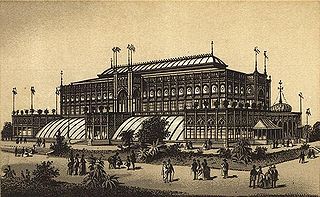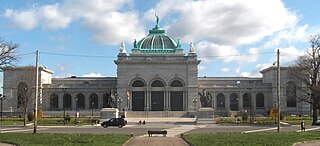
The Centennial comfort stations are two brick buildings in Philadelphia's Fairmount Park originally built for the 1876 Centennial Exposition. [1] They were located south of the now-demolished Horticulture Building and used as public toilets. [2]

The Centennial comfort stations are two brick buildings in Philadelphia's Fairmount Park originally built for the 1876 Centennial Exposition. [1] They were located south of the now-demolished Horticulture Building and used as public toilets. [2]

The two buildings are perhaps the only extant restrooms from a nineteenth century international exposition. They were constructed of brick with wooden elements, slate roofs and copper detailing. Each is about 20 feet (6.1 m) by 22 feet (6.7 m) and one story tall. [1] Seven public comfort stations were built for the exposition, among over 200 other buildings. Only four Centennial buildings survive on their original sites: Memorial Hall, the Ohio State Building, and the two comfort stations. [3] [4]
The Horticulture Building was one of the few buildings at the exposition intended to be permanent, and the comfort houses were likely built of brick so that they could continue to serve the Horticulture Building. When the Horticulture Building was destroyed in 1955, they were used as storage space and greatly deteriorated. [5] A new Horticulture Center was constructed for the 1976 United States Bicentennial immediately north of the comfort stations. Renovation of the stations began in 2011 for use by the Shofuso Japanese House and Gardens, the eastern station as an exhibition space, and the western as a restroom. The eastern station renovation has been completed, while the western station is still in use as storage space. [1] [6]
During renovation, before 2016, the buildings were served by a port-a-potty.
The comfort stations are located within the 1972 Fairmount Park historic district listing on the National Register of Historic Places, but are not included among the 43 buildings in its inventory of historic buildings. [7]

A world's fair, also known as a universal exhibition or an expo, is a large global exhibition designed to showcase the achievements of nations. These exhibitions vary in character and are held in different parts of the world at a specific site for a period of time, typically between three and six months.

The Sesqui-Centennial International Exposition of 1926 was a world's fair in Philadelphia, Pennsylvania. Its purpose was to celebrate the 150th anniversary of the signing of the United States Declaration of Independence, and the 50th anniversary of the 1876 Centennial Exposition.

The Centennial International Exhibition, officially the International Exhibition of Arts, Manufactures, and Products of the Soil and Mine, was held in Philadelphia from May 10 to November 10, 1876. It was the first official world's fair to be held in the United States, and coincided with the centennial anniversary of the Declaration of Independence's adoption in Philadelphia on July 4, 1776.

Frank Heyling Furness was an American architect of the Victorian era. He designed more than 600 buildings, most in the Philadelphia area, and is remembered for his diverse, muscular, often inordinately scaled buildings, and for his influence on the Chicago-based architect Louis Sullivan. Furness also received a Medal of Honor for bravery during the Civil War.

The Philadelphia Museum of Art (PMoA) is an art museum originally chartered in 1876 for the Centennial Exposition in Philadelphia. The main museum building was completed in 1928 on Fairmount, a hill located at the northwest end of the Benjamin Franklin Parkway at Eakins Oval. The museum administers collections containing over 240,000 objects including major holdings of European, American and Asian origin. The various classes of artwork include sculpture, paintings, prints, drawings, photographs, armor, and decorative arts.

Fairmount Park is the largest municipal park in Philadelphia and the historic name for a group of parks located throughout the city. Fairmount Park consists of two park sections named East Park and West Park, divided by the Schuylkill River, with the two sections together totalling 2,052 acres (830 ha). Management of Fairmount Park and the entire citywide park system is overseen by Philadelphia Parks & Recreation, a city department created in 2010 from the merger of the Fairmount Park Commission and the Department of Recreation.

The Arts and Industries Building is the second oldest of the Smithsonian museums on the National Mall in Washington, D.C. Initially named the National Museum, it was built to provide the Smithsonian with its first proper facility for public display of its growing collections. The building, designed by architects Adolf Cluss and Paul Schulze, opened in 1881, hosting an inaugural ball for President James A. Garfield. It was designated a National Historic Landmark in 1971. After being closed since 2004 for repair and renovation, the building reopened in 2021 with a special exhibition, Futures.
Horticultural Hall may refer to:

The Centennial District is a 700-acre section of West Philadelphia, Pennsylvania, United States that contains the Philadelphia Zoo, the Please Touch Museum and the Mann Music Center. The neighborhood sits on a section of town that was the location of the 1876 Centennial Exposition, which was 100 years after the founding of the United States with the signing of the Declaration of Independence.

Centennial Arboretum is an arboretum located at the Horticulture Center, Fairmount Park, at the southeast corner of Belmont and Montgomery Drives, Philadelphia, Pennsylvania. It is open daily without charge.

The architecture of Philadelphia is a mix of historic and modern styles that reflect the city's history. The first European settlements appeared within the present day borders of Philadelphia, Pennsylvania in the 17th century with most structures being built from logs. By the 18th century, brick structures had become common. Georgian and later Federal style buildings dominated much of the cityscape. In the first half of the 19th century, Greek revival appeared and flourished with architects such as William Strickland, John Haviland, and Thomas U. Walter. In the second half of the 19th century, Victorian architecture became popular with the city's most notable Victorian architect being Frank Furness.

The Horticultural Center in Philadelphia, USA, contains an arboretum, greenhouse, demonstration gardens, and an exhibition hall. It is located within Fairmount Park at the southeast corner of Belmont and Montgomery Drives. The grounds are open daily except holidays, without charge. An admission fee is charged for the Japanese house.

Memorial Hall is a Beaux-Arts style building which is located in the Centennial District of West Fairmount Park, Philadelphia, Pennsylvania. Built as the art gallery for the 1876 Centennial Exposition, it is the only major structure from that exhibition to survive. It subsequently housed the Pennsylvania Museum of Industrial Art.

The Please Touch Museum is a children's museum located in the Centennial District of Philadelphia, Pennsylvania, United States. The museum focuses on teaching children through interactive exhibits and special events, mostly aimed at children seven years old and younger.

The Centennial National Bank is a historic building in Philadelphia, Pennsylvania. Designed by noted Philadelphia architect Frank Furness and significant in his artistic development, it was built in 1876 as the headquarters of the eponymous bank that would be the fiscal agent of the Centennial Exposition. The building housed a branch of the First Pennsylvania Bank from 1956 until Drexel University purchased it c. 1976. Drexel renovated it between 2000-2002 and now uses it as an alumni center. The Centennial National Bank, described as "one of the best pieces of architecture in West Philadelphia," was placed on the National Register of Historic Places in 1971.

Wilson Brothers & Company was a prominent Victorian-era architecture and engineering firm based in Philadelphia, Pennsylvania. The company was regarded for its structural expertise.
Clarence Howard Clark Sr. was a banker, land owner, and developer in Philadelphia, Pennsylvania. Ten years after his death, The New York Times called him one of the city's "most prominent men of his day."

Herman J. Schwarzmann (1846–1891), also known as Hermann J. Schwarzmann, was a German-born American architect who practiced in Philadelphia and later in New York City.

The Ohio House, or the Ohio State Building, is an historic, American building that is located in west Fairmount Park, Philadelphia.